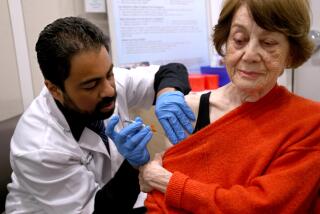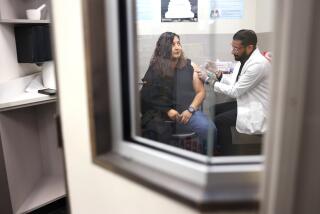Flu Shots Urged for At-Risk People
- Share via
ATLANTA — Hospitals, nursing homes and doctors around the country are urging patients to get flu shots in the wake of last year’s epidemic.
But they agree with public health officials that there is simply no way to tell if the early precautions are really necessary.
“It’s very difficult to guesstimate what will happen during this flu season,” said Dr. Kathleen Gekowski of Cooper Hospital in Camden, N.J., which was so full of flu patients last year that it ordered ambulances to take all but the most critical patients to other hospitals.
The federal Centers for Disease Control in Atlanta is urging people at highest risk of complications from the flu to get vaccinated early this fall.
The CDC recommends that anyone over age 65, in a nursing home, who has heart or lung problems or a weakened immune system get vaccinated. It takes two weeks for the vaccine to take effect.
Every year, flu kills 10,000 Americans.
Flu season usually begins in early winter, but last year it was in full swing by October and had reached epidemic proportions by December.
People flooded public health clinics seeking the vaccine, and many places ran out. So this year manufacturers have provided 50 million doses, up from 32 million last year.
Doctors in the areas hardest hit last year--particularly New Jersey and Connecticut--are calling patients to urge them to come in for their shots.
“Of the people who need the flu vaccine, only about 30% usually get it,” said Dr. Henry Feder Jr. of the University of Connecticut Health Center, which was nearly full with flu patients last winter. “Maybe with the idea of a cold winter and the problems we had last year, that number will increase.”
And they’re hoping the vaccine will work. Because different flu strains circulate every year, there’s no foolproof way to know which to fight.
“But it’s clear that even when the vaccine does not protect from disease, it protects from serious complications and even death,” said Nancy Cox, chief of influenza for the CDC.
Every January, scientists with the CDC and U.S. Food and Drug Administration put their heads together to brew a vaccine. They pull out all the data on which strains dominated that year and which strain was the last to appear.
But because the flu season doesn’t end until March, there’s always a chance that new strains will emerge after the scientists begin to grow the virus, which they use to mix up the vaccine.
The two major strains--Beijing and Taiwan flu--usually alternate years, Cox said. Beijing hit last year, so doctors expect this year’s hardest cases to be Taiwan flu, which the new vaccine targets, she said.
But the Texas flu, a little-known variant of Taiwan, popped up late last year. Scientists expect that it could be what is known as a “herald wave,” a ripple that warns that a particular strain is gaining strength and could return next flu season. So Texas flu is in the vaccine too.
The real trick is getting everybody who needs the vaccine to get it.
More to Read
Sign up for Essential California
The most important California stories and recommendations in your inbox every morning.
You may occasionally receive promotional content from the Los Angeles Times.










